The Wearable Injectors Market is estimated to be valued at USD 9.1 billion in 2025 and is projected to reach USD 28.9 billion by 2035, registering a compound annual growth rate (CAGR) of 12.3% over the forecast period.
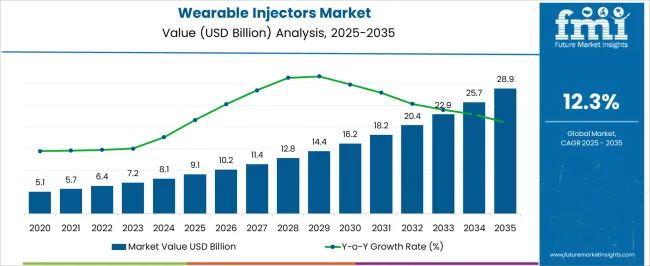
| Metric | Value |
|---|---|
| Wearable Injectors Market Estimated Value in (2025 E) | USD 9.1 billion |
| Wearable Injectors Market Forecast Value in (2035 F) | USD 28.9 billion |
| Forecast CAGR (2025 to 2035) | 12.3% |
The wearable injectors market is experiencing significant growth due to rising demand for patient-centric drug delivery systems that enhance compliance, convenience, and treatment adherence. Increasing prevalence of chronic diseases requiring long-term injectable therapies, such as diabetes, autoimmune disorders, and oncology indications, is driving adoption of wearable devices. Technological advancements in wearable injection mechanisms, coupled with compact and user-friendly designs, are facilitating self-administration and reducing the need for frequent hospital visits.
Integration of smart features, including dose tracking, alerts, and connectivity to mobile health platforms, is supporting broader adoption by both patients and healthcare providers. Regulatory approvals and guidelines supporting safe and effective use of wearable injectors are further strengthening market confidence.
The shift toward home-based care models and telehealth initiatives is also encouraging the adoption of wearable injectors across various therapeutic areas As pharmaceutical companies increasingly collaborate with device manufacturers to develop innovative, patient-focused solutions, the market is expected to maintain a strong growth trajectory, driven by both technological advancements and evolving healthcare delivery models.
The wearable injectors market is segmented by type, mechanism of injection, usage, application, end user, and geographic regions. By type, wearable injectors market is divided into On-Body and Off-Body. In terms of mechanism of injection, wearable injectors market is classified into Spring Driven, Motor Driven, Rotary Pump, Pressurized Gas, and Others. Based on usage, wearable injectors market is segmented into Disposable and Semi-Reusable. By application, wearable injectors market is segmented into Oncology, Infectious Disease, Cardiovascular Disease, Autoimmune Disease, Immunodeficiency, and Other. By end user, wearable injectors market is segmented into Hospitals, Clinics, Home Care, and Others. Regionally, the wearable injectors industry is classified into North America, Latin America, Western Europe, Eastern Europe, Balkan & Baltic Countries, Russia & Belarus, Central Asia, East Asia, South Asia & Pacific, and the Middle East & Africa.
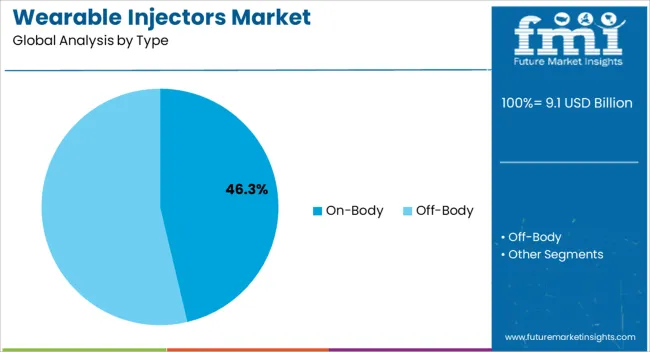
The on-body segment is projected to hold 46.3% of the wearable injectors market revenue share in 2025, making it the leading type category. Its dominance is being driven by the convenience and comfort offered to patients for extended and controlled drug delivery. On-body devices allow for automated or semi-automated dosing over extended periods, which enhances treatment adherence for chronic conditions.
The wearable design also minimizes the need for frequent injections, reducing patient discomfort and improving quality of life. This segment is being further supported by technological improvements that integrate sensors and connectivity features, enabling real-time monitoring and dose management.
Growing preference for self-administration in home-care settings and increasing awareness of patient-friendly drug delivery options have accelerated adoption Additionally, the ability to accommodate a wide range of biologics, including high-volume and viscous formulations, has reinforced the position of on-body devices as the most versatile and widely adopted type in the wearable injectors market.
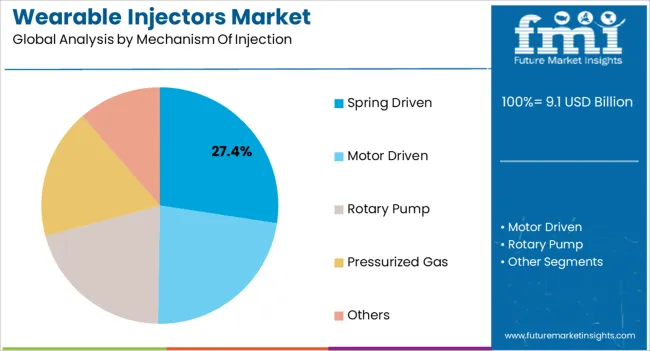
The spring-driven mechanism of injection segment is expected to account for 27.4% of the wearable injectors market revenue share in 2025, establishing itself as a leading mechanism. Its adoption is being driven by simplicity, reliability, and cost-effectiveness in delivering controlled doses over a pre-set period. Spring-driven mechanisms enable precise, repeatable injections without requiring external power sources, making them suitable for both hospital and home-use settings.
The design also allows for compact and lightweight devices, which enhances patient comfort during prolonged therapy. Manufacturers favor spring-driven systems due to ease of integration with existing drug formulations and compatibility with a range of viscosities.
The segment is being further propelled by increasing demand for disposable and user-friendly injectors that simplify self-administration and reduce training requirements Continuous innovation in spring mechanism design and dosing accuracy is ensuring that this segment remains a preferred choice among wearable injector mechanisms globally.
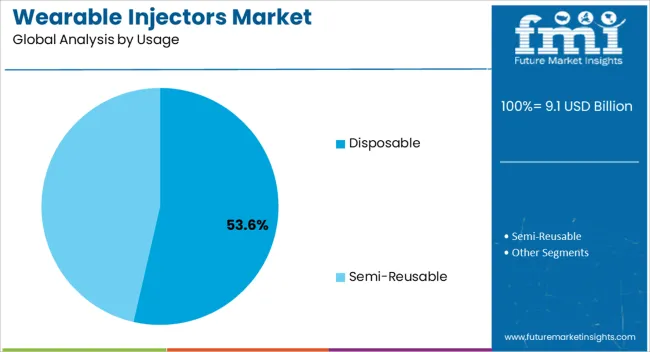
The disposable usage segment is anticipated to hold 53.6% of the wearable injectors market revenue share in 2025, making it the dominant usage category. Its leadership is being reinforced by the convenience and safety associated with single-use devices, which minimize the risk of contamination and dosing errors.
Disposable injectors reduce the need for maintenance, sterilization, and device management, aligning with the growing preference for patient-friendly and low-maintenance therapeutic solutions. The segment is also being driven by regulatory encouragement for safe, single-use devices, particularly in home-care and outpatient settings.
Additionally, the scalability of disposable injectors allows pharmaceutical companies to pair them with a wide variety of biologics and drug formulations, including high-volume and viscous medications The combination of ease of use, infection control, and compatibility with advanced drug delivery technologies has positioned disposable wearable injectors as the preferred choice, supporting their continued dominance in the global market.
The market for wearable injectors is expected to be valued at over US$ 6.40 billion in 2025 and is anticipated to grow at a CAGR of 12.3% to reach US$ 19.70 billion by 2035.
| Report Attribute | Details |
|---|---|
| Wearable Injectors Market Value (2025) | US$ 6.40 Billion |
| Wearable Injectors Market Anticipated Value (2035) | US$ 19.70 Billion |
| Wearable Injectors Market Growth Rate (2025 to 2035) | 12.3% CAGR |
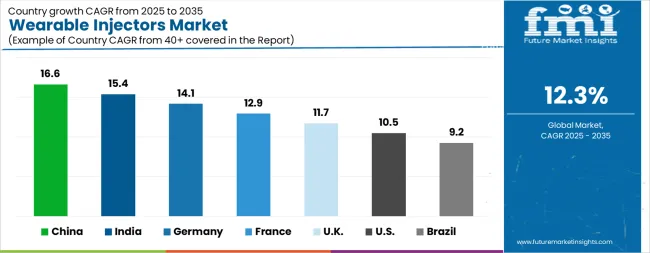
| Country | CAGR |
|---|---|
| China | 16.6% |
| India | 15.4% |
| Germany | 14.1% |
| France | 12.9% |
| UK | 11.7% |
| USA | 10.5% |
| Brazil | 9.2% |
The Wearable Injectors Market is expected to register a CAGR of 12.3% during the forecast period, exhibiting varied country level momentum. China leads with the highest CAGR of 16.6%, followed by India at 15.4%. Developed markets such as Germany, France, and the UK continue to expand steadily, while the USA is likely to grow at consistent rates. Brazil posts the lowest CAGR at 9.2%, yet still underscores a broadly positive trajectory for the global Wearable Injectors Market. In 2024, Germany held a dominant revenue in the Western Europe market and is expected to grow with a CAGR of 14.1%. The USA Wearable Injectors Market is estimated to be valued at USD 3.2 billion in 2025 and is anticipated to reach a valuation of USD 8.5 billion by 2035. Sales are projected to rise at a CAGR of 10.5% over the forecast period between 2025 and 2035. While Japan and South Korea markets are estimated to be valued at USD 493.5 million and USD 245.4 million respectively in 2025.
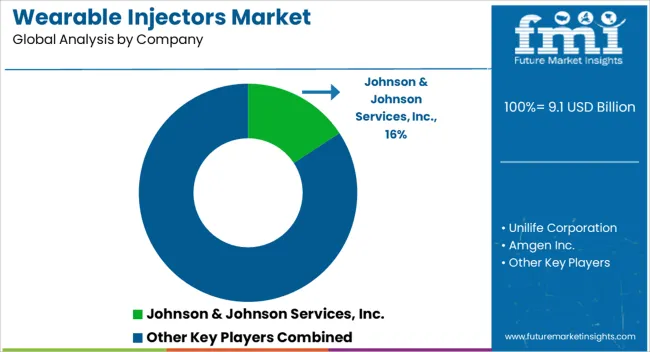
| Item | Value |
|---|---|
| Quantitative Units | USD 9.1 Billion |
| Type | On-Body and Off-Body |
| Mechanism Of Injection | Spring Driven, Motor Driven, Rotary Pump, Pressurized Gas, and Others |
| Usage | Disposable and Semi-Reusable |
| Application | Oncology, Infectious Disease, Cardiovascular Disease, Autoimmune Disease, Immunodeficiency, and Other |
| End User | Hospitals, Clinics, Home Care, and Others |
| Regions Covered | North America, Europe, Asia-Pacific, Latin America, Middle East & Africa |
| Country Covered | United States, Canada, Germany, France, United Kingdom, China, Japan, India, Brazil, South Africa |
| Key Companies Profiled | Johnson & Johnson Services, Inc., Unilife Corporation, Amgen Inc., Enable Injections, Becton, Dickinson and Company, Insulet Corporation, Steady Med Therapeutics, Inc., F. Hoffmann-La Roche Ltd., CeQur SA, West Pharmaceutical Services, Inc., and Bühler Motor GmbH |
The global wearable injectors market is estimated to be valued at USD 9.1 billion in 2025.
The market size for the wearable injectors market is projected to reach USD 28.9 billion by 2035.
The wearable injectors market is expected to grow at a 12.3% CAGR between 2025 and 2035.
The key product types in wearable injectors market are on-body and off-body.
In terms of mechanism of injection, spring driven segment to command 27.4% share in the wearable injectors market in 2025.






Our Research Products

The "Full Research Suite" delivers actionable market intel, deep dives on markets or technologies, so clients act faster, cut risk, and unlock growth.

The Leaderboard benchmarks and ranks top vendors, classifying them as Established Leaders, Leading Challengers, or Disruptors & Challengers.

Locates where complements amplify value and substitutes erode it, forecasting net impact by horizon

We deliver granular, decision-grade intel: market sizing, 5-year forecasts, pricing, adoption, usage, revenue, and operational KPIs—plus competitor tracking, regulation, and value chains—across 60 countries broadly.

Spot the shifts before they hit your P&L. We track inflection points, adoption curves, pricing moves, and ecosystem plays to show where demand is heading, why it is changing, and what to do next across high-growth markets and disruptive tech

Real-time reads of user behavior. We track shifting priorities, perceptions of today’s and next-gen services, and provider experience, then pace how fast tech moves from trial to adoption, blending buyer, consumer, and channel inputs with social signals (#WhySwitch, #UX).

Partner with our analyst team to build a custom report designed around your business priorities. From analysing market trends to assessing competitors or crafting bespoke datasets, we tailor insights to your needs.
Supplier Intelligence
Discovery & Profiling
Capacity & Footprint
Performance & Risk
Compliance & Governance
Commercial Readiness
Who Supplies Whom
Scorecards & Shortlists
Playbooks & Docs
Category Intelligence
Definition & Scope
Demand & Use Cases
Cost Drivers
Market Structure
Supply Chain Map
Trade & Policy
Operating Norms
Deliverables
Buyer Intelligence
Account Basics
Spend & Scope
Procurement Model
Vendor Requirements
Terms & Policies
Entry Strategy
Pain Points & Triggers
Outputs
Pricing Analysis
Benchmarks
Trends
Should-Cost
Indexation
Landed Cost
Commercial Terms
Deliverables
Brand Analysis
Positioning & Value Prop
Share & Presence
Customer Evidence
Go-to-Market
Digital & Reputation
Compliance & Trust
KPIs & Gaps
Outputs
Full Research Suite comprises of:
Market outlook & trends analysis
Interviews & case studies
Strategic recommendations
Vendor profiles & capabilities analysis
5-year forecasts
8 regions and 60+ country-level data splits
Market segment data splits
12 months of continuous data updates
DELIVERED AS:
PDF EXCEL ONLINE
Large Volume Wearable Injectors Market Growth - Trends & Forecast 2025 to 2035
Wearable Fall Detector Market Size and Share Forecast Outlook 2025 to 2035
Wearable Industrial Exoskeleton Devices Market Size and Share Forecast Outlook 2025 to 2035
Wearable Healthcare Devices Market Size and Share Forecast Outlook 2025 to 2035
Wearable Sensor Market Size and Share Forecast Outlook 2025 to 2035
Wearable Sleep Tracker Market Forecast and Outlook 2025 to 2035
Wearable Medical Device Market Size and Share Forecast Outlook 2025 to 2035
Wearable Defibrillator Patch Market Analysis - Size, Share, and Forecast Outlook 2025 to 2035
Wearable Fitness Tracker Market Size and Share Forecast Outlook 2025 to 2035
Wearable Translator Market Size and Share Forecast Outlook 2025 to 2035
Wearable Cardioverter Defibrillator Market Size and Share Forecast Outlook 2025 to 2035
Wearable Electronics Market Size and Share Forecast Outlook 2025 to 2035
Wearable Band Market Size and Share Forecast Outlook 2025 to 2035
Wearable Gaming Technology Market Size and Share Forecast Outlook 2025 to 2035
Wearable Beauty Market Size, Growth, and Forecast for 2025 to 2035
Wearable Medical Robots Market - Trends & Forecast 2025 to 2035
Wearable Computing Market Trends – Growth & Forecast 2025 to 2035
Wearable Blood Pressure Monitor Market Trends and Forecast 2025 to 2035
Wearable Pregnancy Devices Market Trends and Forecast 2025 to 2035
Wearable Fitness Technology Market Insights - Trends & Forecast 2025 to 2035

Thank you!
You will receive an email from our Business Development Manager. Please be sure to check your SPAM/JUNK folder too.
Chat With
MaRIA